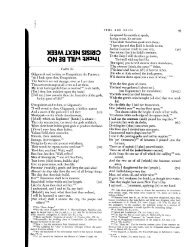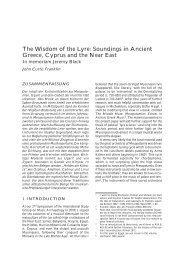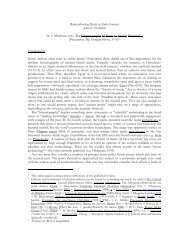KINYRAS AT PYLOS John C. Franklin University of Vermont Kinyras ...
KINYRAS AT PYLOS John C. Franklin University of Vermont Kinyras ...
KINYRAS AT PYLOS John C. Franklin University of Vermont Kinyras ...
Create successful ePaper yourself
Turn your PDF publications into a flip-book with our unique Google optimized e-Paper software.
texts. Yet they are equally indicative <strong>of</strong> the sort <strong>of</strong> temple-musician guilds that are known from<br />
Ugarit and the Bible. 13<br />
When one considers these wide-ranging knr-titles against the fact that ‘balag’ was a<br />
productive name-forming element for much <strong>of</strong> the Sumerian period—including two certain<br />
examples <strong>of</strong> names born by temple musicians—one has a reasonable basis for positing the<br />
development ‘kinyras’ = title > ‘<strong>Kinyras</strong>’ = name. 14 Especially interesting in this connection is a<br />
recently discovered oath-text from the sanctuary <strong>of</strong> Aphrodite at Paphos, composed in the time<br />
<strong>of</strong> Tiberius but incorporating traditional sacral formulations, in which kenuristês is found as a<br />
cult-title <strong>of</strong> Apollo. 15 On Cyprus, and in this particular location, that epiklêsis ineluctably<br />
summons <strong>Kinyras</strong> (and the Kinyradai), who is effectively glossed as ‘kinyrist’, revealing the<br />
same sense <strong>of</strong> agency which has been posited above for the Pylian ki-nu-ra.<br />
When the Ugaritic Pantheon texts became known in the 1960s, the knr-god, who appears<br />
alongside other divinized cultic apparatus and could receive <strong>of</strong>ferings like any other god, was<br />
promptly hailed by many Semiticists as a forebear <strong>of</strong> the legendary Cypriote priest-king. 16 (The<br />
most accurate genealogical metaphor would make <strong>Kinyras</strong> his first-cousin-once-removed). To<br />
interpret the Pylian ki-nu-ra as a sacred instrument <strong>of</strong> West Semitic type, receiving <strong>of</strong>ferings like<br />
his Ugaritic cousin, would doubtless raise a few eyebrows (and what then would be a meaningful<br />
function for me-nu-a2?). But the Divine Knr could provide indirect illumination. His appearance<br />
in a fragmentary text <strong>of</strong> a semi-narrative nature—alongside other personified temple instruments,<br />
13 Cf. West 1997, 57; further discussion and references in <strong>Franklin</strong> 2006, 46 and nn. 19–20. For <strong>Kinyras</strong><br />
as the founder <strong>of</strong> Aphrodite’s temple at Paphos, and the Kinyradai, Pind. Pyth. 2.15–17 with scholia; Ptol.<br />
Megalop. FGrH 161 F 1; Tac. Hist. 2.3.2 f.; Apollod. Bibl. 3.14.3; Arn. Adv. nat. 4.24, 5.19; Clem. Alex. Protr.<br />
2.13.4; Firmicus Maternus, De errore 10; Hsch. s.v. Kinurãdai.<br />
14 B a l a g . d i as agent-word and title: Hartmann 1960, 64 f.; b a l a g is frequently attested as a name-<br />
forming element from Early Dynastic I through the Neo-Sumerian period: eadem 165, 169, 182.<br />
15 Apollo kenuristês: Cayla 2001, 78–81.<br />
16 Jirku 1963; Astour 1966, 281; Nougayrol 1968, 59; Albright 1968, 143 f., 147 f.; Baurain 1980, 305 f.<br />
(with J.-P. Olivier ap. n. 150); Ribichini 1981, 48–51. I prefer to use the radical Knr, as expressed in<br />
alphabetic cuneiform, rather than the specifically Ugaritic voicing as kinnarum (as rendered in the Akkadian<br />
version <strong>of</strong> the Pantheon text), as better suggesting the divinzed lyre as a larger West Semitic phenomenon.






